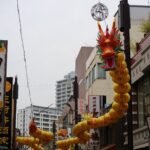Looking for the ultimate list of the best Japanese movies of all time? Dive into our essential guide featuring legendary directors and unforgettable stories.
Japanese movies possess an enchanting allure and are graced by remarkable directors. While Akira Kurosawa stands out as one of the greatest filmmakers worldwide, he’s not the sole renowned director hailing from Japan. Yasujiro Ozu, Hayao Miyazaki, Kenji Mizoguchi, Kon Ichikawa, and others have crafted awe-inspiring masterpieces like “Tokyo Story,” “Seven Samurai,” and “My Neighbor Totoro,” greatly enriching the world of cinema.
From the era of silent films to the golden age of post-war cinema, they birthed a punky and thought-provoking new wave in the 1960s, an explosive surge of animated creations. Many of these works have left an indelible impact in both America and Europe.
Table of Contents
1. Seven Samurai (1954)
![Masterpieces You Can't Miss: 15 Best Japanese Movies of All Time [2025] 6 Seven Samurai Best Japanese Movies Of All Time](https://tokyocandies.com/wp-content/uploads/2023/08/8GITPO9jjF4lMR957O9L0jLabJs2sG-1024x768.png)
Director: Akira Kurosawa
If you’re searching for a Japanese movie, a global movie, or simply an introduction to the world of cinema, why not start with this film? It’s one of Akira Kurosawa’s finest creations and has been a starting point for countless generations of movie lovers due to its simplicity.
The story is set in a poor Japanese village surrounded by bandits. The villagers pool their meager resources and hire a group of unconventional samurai to defend their homes. From this simple setup, Kurosawa weaves an epic tale that sweeps you along with emotions like excitement, happiness, and empathy.
In Hollywood, almost everyone has drawn inspiration from the Seven Samurai plot.
2. Spirited Away (2001)
![Masterpieces You Can't Miss: 15 Best Japanese Movies of All Time [2025] 7 Spirited Away Best Japanese Movies Of All Time](https://tokyocandies.com/wp-content/uploads/2023/08/cover-1024x554.jpeg)
Director: Hayao Miyazaki
The mesmerizing universe portrayed in this animated movie is a creation of Hayao Miyazaki’s incredible mind. Yet, fans have ventured across places in the world, hoping to find spots that might have inspired or resembled the peculiar bathhouse showcased in the film.
With its captivating characters like ravenous spirits and a six-limbed cauldron man, this Oscar-winning film stands out in our world dominated by digital technology. Even if it took a whole month to make just one minute of the scene, every frame is hand-drawn. This film demonstrates that the worth of animation remains remarkably high.
3. AKIRA (1988)
![Masterpieces You Can't Miss: 15 Best Japanese Movies of All Time [2025] 8 Akira Best Japanese Movies Of All Time](https://tokyocandies.com/wp-content/uploads/2023/08/Testuo-Shima-Akira-1024x642.jpg)
Director: Katsuhiro Otomo
“AKIRA,” based on Katsuhiro Otomo’s grand sci-fi manga, offered a glimpse into a future world (though it’s now in the past, set in 2019) that had a significant impact. This influence can be spotted in various creations referred to as “cyberpunk.” The iconic bike-sliding scene has been revered in many animations that followed.
The stunning visuals of flashy, capitalist, and decaying neighborhoods are truly striking. This animated movie, mingling horror with grotesque imagery, is uniquely original. A seemingly uncomplicated and emotional tale about discontented young individuals transforms into a work that culminates in a remarkable showdown between Kaneda, the leader of a motorcycle gang, and his childhood friend Tetsuo.
4. Harakiri (1962)
![Masterpieces You Can't Miss: 15 Best Japanese Movies of All Time [2025] 9 Harakiri Best Japanese Movies Of All Time](https://tokyocandies.com/wp-content/uploads/2023/08/harakiri-1.webp)
Director: Masaki Kobayashi
Masaki Kobayashi’s masterpiece holds the highest spot in Samurai cinema, without a doubt. Even “Seven Samurai” falls short in comparison. The climax is a sudden burst of violence.
What makes this work unique is its storytelling structure. It starts with a ronin seeking permission to perform seppuku at the Edo residence of a mighty feudal lord. Then, it delves into flashbacks depicting the suffering and shame of another Ronin who had made the same request. Are these two stories intertwined? Is something dreadful about to unfold?
5. CURE (1997)
![Masterpieces You Can't Miss: 15 Best Japanese Movies of All Time [2025] 10 Cure Best Japanese Movies Of All Time](https://tokyocandies.com/wp-content/uploads/2023/08/Cure-Kyua-1997-1108x0-c-default-1024x768.jpg)
Director: Kiyoshi Kurosawa
Detectives are faced with a string of baffling murders. The bodies of the victims bear a haunting letter “X” carved into them, and nearby criminals confess without memory. They claim to have no recollection.
Inspired by American horror movies, Kiyoshi Kurosawa crafted this film as a tribute to them. Amidst the prominence of supernatural films like “The Ring” and “The Grudge,” “Cure” stands as a formidable precursor to the “J-horror” movement that swept the globe in the late ’90s.
6. Perfect Blue (1997)
![Masterpieces You Can't Miss: 15 Best Japanese Movies of All Time [2025] 11 Perfect Blue Best Japanese Movies Of All Time](https://tokyocandies.com/wp-content/uploads/2023/08/perfect-blue-1998-girl-sees-fishes-bfi-00m-z34.jpg)
Director: Satoshi Kon
Satoshi Kon kept exploring the idea of the Internet as a dream world, right until his last work, Paprika. But it’s in his debut work that this theme is brought to life most chillingly. Through the eyes of the main character, Mima, you experience how an idol-turned-actress loses touch with reality while being pursued by her paranoid fans.
With sharp editing and a straightforward narrative, every scene feels uncertain. The portrayal of online harassment and the darkness within the interconnected digital realm in this film (made in 1997) was not just unsettling, but strangely predictive of what lay ahead in the future.
7. My Neighbor Totoro (1988)
![Masterpieces You Can't Miss: 15 Best Japanese Movies of All Time [2025] 12 My Neighbor Totoro Best Japanese Movies Of All Time](https://tokyocandies.com/wp-content/uploads/2023/08/image-asset-4-1024x683.jpeg)
Director: Hayao Miyazaki
The world that Studio Ghibli brings to life is filled with brave girls and magical beings, but none might be as renowned as the forest spirit in the title. “Totoro” is even the official symbol of Studio Ghibli.
Taking place in post-war Japan, this delightful tale follows two sisters who move to a rural town and encounter a family of enigmatic and friendly creatures in the nearby woods. Unlike the later stories from the studio that draw on Western fairy tales with wicked witches and grand battles between good and evil, this one is different.
However, the charm of Miyazaki’s magic in Ghibli’s classics is more than enough to keep them cherished by generations.
8. Fireworks (1997)
![Masterpieces You Can't Miss: 15 Best Japanese Movies of All Time [2025] 13 Fireworks Best Japanese Movies Of All Time](https://tokyocandies.com/wp-content/uploads/2023/08/hanabi002.jpg)
Director: Takeshi Kitano
This movie has director Takeshi Kitano in a starring role too. He portrays a detective who has a wife with leukemia and a partner who gets paralyzed while on duty. The reserved main character gets caught up in a yakuza deal, while his former sidekick tries his hand at art. This movie brings about a yakuza story that’s serene, thoughtful, and stunning in a way we haven’t seen before.
What’s even more intriguing is that the person who made this film, Kitano, is the same guy known as the “castle lord” from the legendary audience-participation TV show “Exciting Nariyuki Program Fuun! Takeshi’s Castle”.
9. Phantom Light (1995)
![Masterpieces You Can't Miss: 15 Best Japanese Movies of All Time [2025] 14 Phantom Light Best Japanese Movies Of All Time](https://tokyocandies.com/wp-content/uploads/2023/08/MaborosiHigherRes.png)
Director: Hirokazu Kore-eda
Hirokazu Kore-eda’s first movie is famous for films like “Wonderful Life” and “Shoplifters.” It’s a sorrowful drama about a woman whose husband’s suicide leaves her searching for answers. This isn’t the kind of work that immediately lifts your spirits. It’s somber without sinking into sadness, and it’s both slow-paced and beautifully soothing.
The contrast between the quiet, chilly streets of Osaka and the stunning landscapes of the windswept Noto Peninsula is striking. Yet, what sticks in the memory is how much time he dedicates to portraying the lonely woman.
10. Battle Royale (2000)
![Masterpieces You Can't Miss: 15 Best Japanese Movies of All Time [2025] 15 Battle Royale Best Japanese Movies Of All Time](https://tokyocandies.com/wp-content/uploads/2023/08/resize.webp)
Director: Kinji Fukasaku
For a whole generation, this dystopian thriller marked their introduction to Japanese cinema. The story unfolds in a near-future Japan plagued by economic decline, joblessness, and juvenile delinquency. It revolves around a brutal contest where only one middle school student is permitted to survive, orchestrated by the government as a sanctioned method of population control.
While it shares similarities with “The Hunger Games,” this work doesn’t water down its portrayal of violence for younger audiences, and its satire hits home effectively. Even now, following the popularity of “Squid Game,” the critique of authoritarianism in this film still strikes a chord.
11. Grave of the Fireflies (1988)
![Masterpieces You Can't Miss: 15 Best Japanese Movies of All Time [2025] 16 Grave Of The Fireflies Best Japanese Movies Of All Time](https://tokyocandies.com/wp-content/uploads/2023/08/100776423_capture.jpg.webp)
Director: Isao Takahata
A touching tale from Studio Ghibli about two kids who lost their mom in an air raid and faced malnutrition. The struggles of regular people in wartime Japan have rarely been depicted as powerfully.
While not as famous as Studio Ghibli’s co-founder Hayao Miyazaki (whose “My Neighbor Totoro” was released on the same day), Isao Takahata left a profound impact on Japanese audiences.
In this exquisite animated gem, he skillfully blends childhood innocence with heart-wrenching devastation, accompanied by a moving score by Michio Mamiya. The climax is truly overwhelming.
12. Hausu (1997)
![Masterpieces You Can't Miss: 15 Best Japanese Movies of All Time [2025] 17 Hausu Best Japanese Movies Of All Time](https://tokyocandies.com/wp-content/uploads/2023/08/hausu-1977-1108x0-c-default-1024x768.jpg)
Director: Nobuhiko Obayashi
“House,”(Hausu) released in the late 1970s, was heavily criticized initially but has since garnered a dedicated following. It stands as a defining creation by Nobuhiko Obayashi, a filmmaker hailing from Hiroshima Prefecture. This peculiar horror-comedy revels in a surreal charm, boasting deliberately childish special effects and an affection for artificial aesthetics. Its collage-like imagery adds to its wild perspective.
Centering on a high school girl named “Gorgeous,” the eerie narrative unfolds. She and six friends venture into a house that devours them. The carnivorous piano is especially striking!
13. Drive My Car (2021)
![Masterpieces You Can't Miss: 15 Best Japanese Movies of All Time [2025] 18 Drive My Car Best Japanese Movies Of All Time](https://tokyocandies.com/wp-content/uploads/2023/08/220321165054-drive-my-car-red-saab-restricted-1024x682.jpg)
Director: Ryusuke Hamaguchi
Ryusuke Hamaguchi, an emerging star in the Japanese film scene, seems like a subtle blend of Chekhov and Haruki Murakami. His work became the first Japanese movie to ever be nominated for Best Picture at the Academy Awards, and it even managed to give the car “Saab 900” a cool comeback.
The story revolves around a theater director grieving the loss of his wife who visits Hiroshima to direct “Uncle Vanya.” A young woman named Misaki becomes his local driver due to some complicated car insurance matters.
The connections that unfold might come across as overly sweet and predictable in the wrong (read: Hollywood) hands, but Hamaguchi skillfully captures the complexities of human nature, the tug-of-war between loneliness and the need for connection. It’s a moving tale that weaves together art, sorrow, and healing, gradually expanding its reach.
14. Tokyo Drifter (1966)
![Masterpieces You Can't Miss: 15 Best Japanese Movies of All Time [2025] 19 Tokyo Drifter Best Japanese Movies Of All Time](https://tokyocandies.com/wp-content/uploads/2023/08/Tokyo-Drifter-1-1024x683.jpg)
Director: Seijun Suzuki
In this creation, you can feel the vibrant punk energy of Seijun Suzuki, a filmmaker who embraced movies with joy and excitement.
Starting like an incredibly intense yakuza flick, it might seem a bit nonsensical, transitioning from black and white to a literal explosion of colors along the way.
The storyline (which, again, isn’t the main focus) trails a Yakuza hitman facing his reckoning, relentlessly pursued by a rival gang. Created in a few weeks without rehearsal, the piece was born from its chaotic spontaneity. This is a fierce cinematic explosion of anarchy.
15. Crazy Thunder Road (1980)
![Masterpieces You Can't Miss: 15 Best Japanese Movies of All Time [2025] 20 Crazy Thunder Road Best Japanese Movies Of All Time](https://tokyocandies.com/wp-content/uploads/2023/08/crazy-thunder-road-1108x0-c-default-1024x768.jpg)
Director: Ishii Takeryu
Considering its impact on both Japan’s underground filmmaking and the dystopian cyberpunk scene (like “Akira” and “Tetsuo”), Gakuryu Ishii’s indie motorcycle gang movie was scheduled for a 2022 release. Astonishingly, it hadn’t received proper international distribution until then.
Shot with equipment borrowed from a university, actual motorcycle gangs as the cast, and on a shoestring budget, this work can be seen as a chaotic response from Japan to “Mad Max.” Toei finally gave it a wide release in 1980. Its unexpected success catalyzed a whole generation of guerrilla filmmakers.
- Top 14 Japanese Streetwear Brands That Are Redefining Cool Right Now (2025)

- 15 Tokyo Best Bars You’ll Love [2025 Guide]
![15 Tokyo Best Bars You’ll Love [2025 Guide] 2 Tokyo Best Bars](https://tokyocandies.com/wp-content/uploads/2023/08/image-15-150x150.jpg)
- 16 Best Anime and Manga Stores in Tokyo: Otaku Shopping Guide for Every Fan (2025)

- What to Do in Yokohama with kids: 20+ Must-See Spots & Experiences (2025)

- 10 Best Tokyo Tours You Absolutely Can’t Miss in 2025 (From Foodie Walks to Cultural Adventures)

